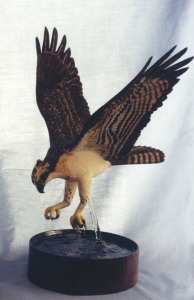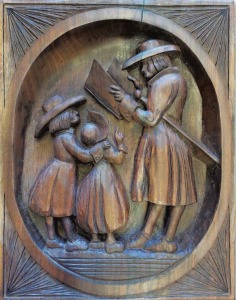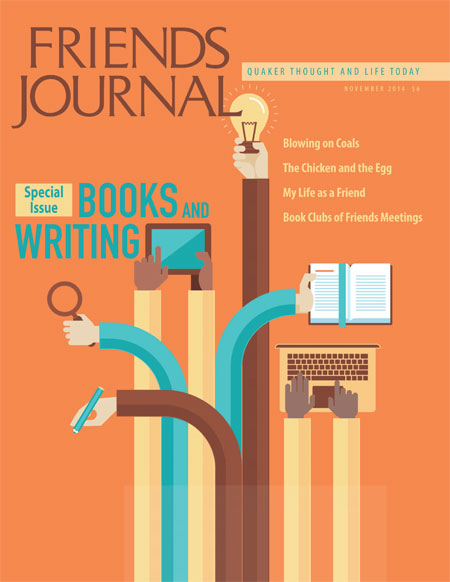In the spring of this year, Friends Journal received a unique gift: a beautiful, intricately detailed woodcarving of our colophon. The 11-by-14-inch piece arrived in the mail and included in the package was a handwritten note, eight and a half pages long, written by the artist Philip C. Scott. Thank you, Philip. The carving is proudly displayed in the front of our office. In his own words and with editing help from our associate editor, Gail Whiffen Coyle, here is his story.
My artwork almost always happened on rainy days. My mother always had art supplies ready for me to use: charcoal, oils, paint. I used to watch my grandmother paint with oil paints; she was very good and served as my early artistic inspiration. She won first place with a pencil drawing she did that was displayed at the Saint Louis Exposition in 1904. Her maiden name was Anna Thomas Cox, and she was born in 1869.

Growing up, I used many different art materials and started whittling when I was a Boy Scout. With a hardly sharp Boy Scout knife, I loved to whittle models out of wood; I made walking sticks and neckerchief slides. Then I got an X-Acto knife kit with all kinds of blades—that was exciting and soon my whittling changed to carving. In school I always got good grades in art, but athletics were my first love. I lived a block and a half from the local playground and spent many hours there playing every game imaginable. Actually, the entire town of Kennett Square, Pennsylvania, was my playground—what a wonderful town to live in for 22 years. I knew every street, alley, and shortcut to get to where I was going. I knew all of the best sledding hills, and I skated on the local ponds when frozen. Those were the days when you organized your own play with your friends without parental interference. We played tag on our bicycles: two teams with three or four on a side, and you got one minute to take off and hide. When found, you could ride hard to avoid being tagged. Usually you would have to abandon your bike to run and hide again. This game often never really ended until everyone was exhausted or scattered so far no one knew where the other people were.
I had a sister, Lois, three years older than me. She was a wonderful cello and piano player and an excellent student. My father was a postal clerk at the Kennett Square Post Office, and my mother used her many talents as a kindergarten teacher. She also ran the Hesscott Kindergarten in our basement at 233 Center Street. I graduated from Kennett High School in 1947 and then from West Chester State Teachers College, which is now West Chester University, with a bachelor’s degree in health and physical education in the class of 1952. I played on the soccer team at West Chester, and in 1950 we made it to the national championship game, defeating number-one ranked Penn State 1-0 in double overtime thus becoming number one in the NCAA.
I enlisted in the United States Marine Corps in 1953 and went to Officer Indoctrination School at Camp Upshur in Quantico, Virginia. In the process of being trained to kill many different ways, my mind began to reject the whole military way of thinking. I could no longer take the fact that I was being trained to be a killer. I withdrew into contemplation of what I thought the New Testament meant to the world. I realized I had lost my freedom to make rational decisions about my life, and I became a conscientious objector. By this point I had been commissioned as a second lieutenant, and so I told my commanding officers that I no longer wanted to be a marine. After about nine months of service, I was honorably discharged from the U.S. Marines.
I felt as though I should serve out the rest of my obligation to my county in service to my faith, which is helping people, not killing people. I was assigned to work for the American Friends Service Committee (AFSC) in its Material Aids Program, packing clothing for overseas. I worked in a large building in Philadelphia, Pennsylvania, and met many wonderful people. They were all people that believed as I did, and several were Japanese Americans who had been in the internment camps during World War II. The director of AFSC’s Material Aids Program at the time was George Oye, a Japanese American who before working for AFSC had taught Japanese at the University of Pennsylvania, instructing U.S. Army officers preparing for the occupation of Japan.

Although I didn’t grow up Quaker, there are Quakers in my lineage. My paternal grandmother, Anna Cox, was a Quaker, and my father (her son) went to Westtown School, a Quaker boarding school in West Chester. However, Anna was disowned from the Quaker community for marrying someone outside of the meeting. She lived in Toughkenamon, a town in Southern Chester County of Kennett Square, and died there in 1944 when I was 15 years old. She went to the Pennsylvania Museum and School of Industrial Art in Philadelphia, which was founded in 1876 in response to the Centennial International Exhibition held in Philadelphia that year. The school separated from the museum in 1964 to become the Philadelphia College of Art; it’s now known as the University of the Arts and the museum is the Philadelphia Museum of Art.
I am a member of Valley Meeting in Wayne, Pennsylvania, and have been since the 1950s. However, I have not attended for many years because of the distance (I now live in Stowe, Vermont) and raising five children. After my service with AFSC ended, I got married to my wife, Roberta, whom I met in college, and we moved to Brattleboro, Vermont. I got a job teaching driver’s education in Brattleboro Union High School. When Roberta was pregnant with our first child, we decided to move back to Pennsylvania to be closer to her family, and I got a job teaching at Friends Select School in Philadelphia. I taught a Quakerism class there but only for one year.

While teaching at Friends Select, the head of school got me a job at College Settlement Camp in Horsham for underprivileged children from Philadelphia. That summer my family and I lived in a small cabin on the campgrounds, and we stayed through the winter. One of the counselors at the camp was Vietnamese and had a PhD in international law from Saigon University and was getting his second PhD from Harvard University—slightly overqualified to be a camp counselor. I became friends with Nguyen Phu Duc who later became the special assistant to the president for foreign affairs (then President Thieu) and was one of the negotiators during the Vietnam War peace talks. He wrote a book called The Viet-Nam Peace Negotiations: Saigon’s Side of the Story, documenting the copious notes that he took every day.
After the cold winter living at College Settlement Camp, we bought a house in King of Prussia, and I applied for a job in the Upper Merion Area School District. I was employed there for 37 years, teaching kindergarten through sixth grade in five different schools for 21 years and high school swimming for 16 years. During that time, I also served as the recreation director for 14 years. Shortly after moving to the area, I started going to Valley Meeting. I had driven past the meetinghouse a few times and decided to check it out. What is more perfect than accepting everyone as equal and believing that there is that of God in every person?

Following my time at Friends Select, I began to read extensively within the Quaker faith of all the historical figures. I find William Penn to be one of the most interesting, but there are many, many more. Friends Journal has been one of my sources for Quaker reading. Every month when I looked at the colophon I would think, That would really look nice carved in depth. I do carvings of all types, but in-depth carving is most intriguing to me. The wood I used is from walnut trees in Pennsylvania. When I picked black walnut as the wood, I thought of William Penn, Penn’s woods, and the holy experiment in Pennsylvania. I carved a smaller version of the colophon first as a gift to friends living in a Friends retirement community in Newtown, Pennsylvania (I like to donate carvings to people and in lieu of payment ask them to donate to AFSC). Then I thought I should do a bigger one for Friends Journal.

I became a serious carver about five years before retiring from teaching in 1993, but it feels like all of my art skills were really postponed until my retirement. I always, at the end of my list of things to do, had art as something to spend more free time on. Now that I’m retired, I spend my rainy days in my shop carving. I have several carvings and paintings that I did early on. I have an oil painting that took me 13 years to finish because I was too busy with family and trying to make a living for seven. I usually had two full-time jobs and maybe a part-time job also. When I first started teaching, teachers did not make very much. Today, it is much better.

Just prior to retiring, I went to a carving show and was inspired to start carving some of the objects I saw. I started paying to meet with several different carving teachers to learn new techniques. I also had to buy several hundred dollars worth of new equipment in order to do these things. My graduate school carving has enabled me to be taught by several nationally known carvers. When you stop learning you might say that will be the end! I am a member of the Green Mountain Wood Carvers Club and have won best of show a couple of times. I enjoy participating in competitions, but there is too much standing around talking. I’d rather be playing tennis. When the sun is out in Vermont everybody is out because we don’t have a lot of sunny days. You appreciate sunny days a lot more when you don’t have many.
Why has man become so uncreative when it comes to dealing with his fellow man? When I would watch propaganda movies in the Marines I would think, This is crazy, and when I watched the hydrogen bomb tests at Eniwetok, I knew that I no longer wanted to be a member of any senseless organization using murder and mayhem toward his fellow man. There has to be a better way.
I wrote a short note to President Obama on one of the Democratic fundraising letters and suggested that instead of sending 30,000 troops to kill men of different thinking why not just dress them like they are dressed and send them with a letter of introduction saying, “We have come to help you. How can we do that?” It’s never been tried, and it would be much less expensive. I also suggested that he attend meeting for worship at his daughters’ school, Sidwell Friends in Washington, D.C.
Nationalism is pitting nation against nation with armed forces costing billions—they are there to protect the greed of the greediest. Men who gain from war are not the men pulling the triggers and dropping the bombs and mending the minds and bodies of the veterans. I attended every peace march on the east coast during the Vietnam War. On April 15, 1967 (the day after my thirty-eighth birthday), I went to New York City with a group from Valley Meeting for the march from Central Park to the United Nations building to protest the war, but we arrived late and were near the back of the long line of over 400,000 people. I decided to jog to the front and arrived at the UN building with John Kerry and the Vietnam Veterans Against the War (VVAW). I then had a very close stand to hear Martin Luther King Jr. address the crowd. Eleven days before, King had given his famous “Beyond Vietnam” speech at Riverside Church in New York City:
Somehow this madness must cease. We must stop now. I speak as a child of God and brother to the suffering poor of Vietnam. I speak for those whose land is being laid waste, whose homes are being destroyed, whose culture is being subverted. I speak for the poor of America who are paying the double price of smashed hopes at home and death and corruption in Vietnam. I speak as a citizen of the world, for the world as it stands aghast at the path we have taken. I speak as one who loves America, to the leaders of our own nation: The great initiative in this war is ours; the initiative to stop it must be ours.
Author chat with Philip:







Comments on Friendsjournal.org may be used in the Forum of the print magazine and may be edited for length and clarity.